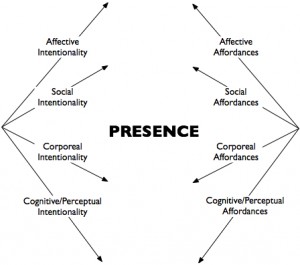TAG 2010
This weekend was the Annual Theoretical Archaeology Group (TAG) conference in Bristol. TAG is a great conference with many wide-ranging topics discussed, and has a tradition of being a platform from which a number of theories that may be conventionally considered ‘out-there’ are presented. It is also treated as the UK archaeological communities’ unofficial Christmas party. This year didn’t disappoint!
I was asked to contribute a paper to the CASPAR session on my work with Augmented Reality. The session was a mixture of papers concerning web-based approaches to archaeology, archaeology in television and radio and also virtual reality. As it was TAG I decided to inject quite a bit of theory into my paper, discussing the use of Turner’s Arc of Intentionality <image> to aid in analysing both real and virtual experiences. I attempted to explain how it is possible to use the Arc of Intentionality to get us a little closer to Husserl’s original ideas of phenomenology. That is, pulling apart an experience and analysing the individual parts.
One of the massive strengths of Augmented Reality in my mind is the simple fact of using the real world as a canvas – and only augmenting in a small amount of virtual objects, just the ones that you need. In a full Virtual Reality experience it is necessary to create the entire world as well – which leads to many many decisions about the experience, that we may not have enough information (or indeed desire) to make. Turner’s AoI then allows us to look at the augmented experience, acknowledge the parts of the virtual objects that ‘don’t quite feel right’ and either discard this part of the experience as unimportant and not something we are interested in – or to refine that particular element to get it closer to feeling like an authentic experience. After I delivered my paper a member of the audience pointed out that actually we may not even want the virtual objects to ‘feel right’ in every way. This is an excellent point and again fits nicely with Husserl’s ideas. If we are just interested in the impact of Hadrian’s Wall (for instance) as a barrier across the landscape – the perfect reconstruction of the mortar isn’t that important – what is important is the fact that you can’t see through it or over it. We need to take the parts of the experience we are interested in and concentrate just on them – rather than getting lost in the details.
I’m not sure I had quite enough time to go enough into the theory to get my point across properly, and I certainly don’t have enough room here but I recently submitted a paper that goes into a lot more detail on this subject, its currently being peer-reviewed, so fingers-crossed they will accept it!
Finally, a nice thing was that my live example of a simple marker-based AR project still seemed to produce the ‘wow’ factor. I guess this shows that AR is still relatively unknown (at least among archaeologists!) – it will be interesting to see where it all goes over the next year.
I have reproduced my slideshow below – and if you want to see the AR example, just print out this marker on a piece of A4 paper and point it at your webcam.
Slideshare:


